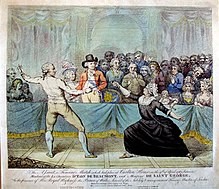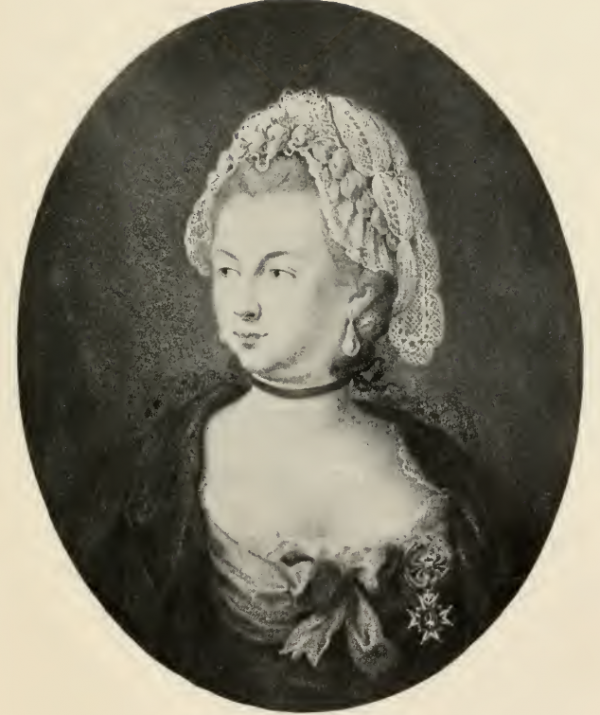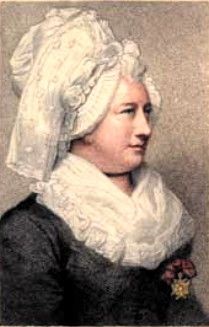
La Chevalière
A Short Story
Based on Strange Fact
By Maryanne Peters
I first met Mademoiselle La Chevalière d'Éon in 1786, a year after she returned to England from France. At the time she was (I was told) 58 years of age, which was 20 years older than me, but she seemed so much younger. In fact, she continued to participate in her famed fencing tournaments for a further 10 years following her return, until serious injury forced her to retire from such activity.
She was a curiosity at the time, because of her skill with the sword, which was my pursuit also. I had the great honor of sparring with her, on more than one occasion. Of course, I had to ask her how she had acquired her martial skills, and this is what she told me.
She was born of a poor but noble family in a town in Burgundy. Apparently because there was no heir to her father’s estate, she was given the name of Charles and was raised as a boy. It was because of this that she was able to receive a full education qualifying in law from the prestigious College Mazarin, and moving from there to public service. Quite how she was able to conceal her femininity was never explained, but she later had occasion to shed her pretense in the service of her king.
Apparently La Chevalière had developed a romantic relationship with Alexander McKenzie-Douglas, a Jacobite Scotsman in the service of the French King. Although she was not specific, I understood that the man she called “Alec”, who was 15 years older than her and a bachelor, knew that she was a woman and that they co-habited. Alec was posted to St. Petersburg and he was able to persuade his employers to send La Chevalière, then employed as a young man, to assist him in the legation in Russia.
While in Russia La Chevalière assumed female clothing and lived entirely as a woman and as consort to Baron McKenzie-Douglas, for six years at the Court of Empress Elizabeth. As a woman she had the opportunity have direct contact with the Empress and her female entourage and (as she told it to me) as a lady in waiting in her household she effectively served as a spy for France.
It would seem that they (she and her Alec) had a family life in Russia. She told me that learned English from her de facto husband, and that they would speak it to confound the Russians who spoke French (as well as their own language on rare occasions).
Ill health forced Alec to return to Paris in 1761 (he was to die two years later) and returning with him, La Chevalière was forced to return to life as a man. That included serving a captain of the dragoons in the latter stages of the Seven Years War. She fought at the Battle of Villinghausen and was wounded in the field at Ultrop. Following recovery at home in Burgundy, she returned to Paris at the age of 33 years.
Her knowledge of English proved an advantage when she was sent to London to assist The Duc de Nivernais in the preparation of the Peace Treaty which was signed in 1763. Again, it was not clear to me the relationship that she had with the Duke, but it must have been close. The Duke promoted her and when he left London she succeeded him to briefly serve as interim Ambassador.
Problems started for La Chevalière when Louis XV sent his new delegate. Upon his arrival in London Le Comte de Guerchy demoted her to secretary in a manner she described as “humiliating”. It appears that the Count was part of a faction in the French Court at odds with La Chevalière and her supporters.
Things became more fraught when the Count decided that he wanted to disrobe La Chevalière to prove that his secretary was not male. She was forced to resist and wrote a letter to the King accusing the Count of trying to drug her. The reasons for him wanting to do this were not disclosed in the letter, which was among those published by her to gain support in London. To some extent it worked, because the British Government declined to take requested action to send her back to France. Furthermore, the published documents generated such public support for the renegade French diplomat that a mob jeered the Count and threw stones at his residence.
However, the Government of France were not pleased. La Chevalière had broken all the rules and was now suing the Le Comte de Guerchy in the English Courts, for attempted murder. His salary was suspended and La Chevalière was forced into hiding.
This she was able to achieve movement in plain sight by resuming female clothes, and in that guise she was able to pass unrecognized. But her concealment was not to last. As she explained it, she held documents embarrassing to King Louis, and finally she was able to negotiate some relief. The Count was recalled to Paris, and La Chevalière received a significant pension, supposedly to buy her silence. But while now able to resume her uniform as captain of the dragoons, she remained in political exile in London.
It was around this time that I first became aware of this person. The London Stock Exchange, which was then engaged in insurance and the purchase of annuities, and other matters of underwriting assessed risks, started a betting pool that La Chevalière was actually a woman. I was one of the people invited to place a bet. By arrangement I met this captain at a social occasion contrived for the purpose, and I placed a modest bet, that she was a woman.
I felt justified when she later shed her male garments. But the betting pool never paid out and bets were returned. She would not submit to the dishonor of appearing naked for the curosity of people such as myself, and rightfully so.
But the reasons for La Chevalière spending the rest of her life as a woman, were not then known. As she later explained it, the embarrassing material that she held against King Louis lost its value with his death in 1774, so she sought to negotiate a return from exile. One condition was that she would need to “resume the costume of that sex to which in France everything is pardoned”. To that end, the new King even offered to fund her new wardrobe.
From that time onward she dressed entirely as a woman. That was what the King insisted upon, but she seemed happy to comply.
La Chevalière did return to France but she was banished to her small home town in Burgundy. That was less to her liking. She enjoyed the vigor of city life, so much so that even Paris was not big enough for her. It was only a matter of time before she returned to London and into our circle.
At that time, she still enjoyed a pension granted to her by Louis XV, but within a year or so, the French Revolution put a stop to that. Not only did her income cease, but her property in France was confiscated. She found herself living without means, and she was more dependent on friends such as myself.
Despite her age, she was very attractive, and she was undoubtedly charming. She spoke with a beautiful throaty voice and that wonderful French accent. She was always well presented and often bore the medal that she had won in battle on the bodice of her dress, as in the portrait engraving shown.

Still she wondered if she might be of service to France. I understand that she offered her services to the Revolutionary National Assembly, suggesting that she could form and lead a division of female soldiers to serve the Republic. But there was no interest.
She found humble lodgings with Mrs. Cole in Hounslow, but as a popular member of London Society and of the French minor aristocracy when the French Revolution was widely opposed in England, she was not short of invitations to soirees and social events.
She supplemented her income with continuing demonstrations of her ability with the sword. She did so up until she was seriously injured in a fencing tournament at Southampton in 1796. I was not present for the event, but I was one who contributed to her care.
I took it upon myself to call upon her from time to time. Since the death of my wife I found myself in need of feminine company, without the complications of being associated with a woman younger than me with expectations that might complicate matters. With La Chevalière I had the pleasure of being in the company of a woman, but yet able to discuss matters of politics, diplomacy and war with a person highly experienced in all of those matters.

The last portrait of her that I am aware of, was painted at about that time. Her copious hair was white by that time, but was still plentiful and worn beautifully styled under her bonnet. To the end of her days, even when bedridden, she maintained that patrician bearing that had won her some many admirers – myself included.
I had often thought that if she were a younger woman I would have proposed marriage to this lady. She seemed to me to be the very essence of womanhood, despite her astonishing experiences when disguised as a man, and her unique capacities the unusual masculine skills she had acquired in those times.
For that reason, perhaps you can understand the depth of my shock when I learned from the examination of her body upon death, in the spring of 1810 at the age of 81, that she was not a woman at all. To the puzzlement of the doctor he found that she had the full body and formed breasts of a woman, but that she also possessed male genitals “in every respect perfectly formed”.
None of this was made known to the mourners when La Chevalière was buried in London, at the churchyard of Saint Pancras. Only much later were the details made known. I for one, will always choose to remember her as a woman. After all, I never knew her as anything else, and quite some woman she was.
The End
© Maryanne Peters 2020
Author’s Note: Every word in the story is fact, except for the narrator himself, who has been invented.


Comments
C'est une histoire plus remarquable, quoi ?
Au poil ! Merci de la partager.
AuP
Portraits
There is a more famous portrait of Charles-Geneviève-Louis-Auguste-André-Timothée d'Éon de Beaumont, which is beautifully real. I often refer to them as part of my intersex support work.
They gave their name to the Beaumont Society
https://www.beaumontsociety.org.uk/
I guessed from the title who this was about
Which doesn't make me a genius i'm sure everyone else did too;
But it sure got my interest...
I've been trying to finish one little story for over a month and haven't been reading anything, but when I saw the title I had to stop everything to read this, and I wasn't disappointed. Trans history has these few very famous stories that have been documented, but how many women like her were never discovered?
~anyway good stuff, Veronica
,
And on the subject of historical TG stories:
I'd love to read one about a girl who worked at Magnus Hirschfield's clinic at the time Lily Elba was there, named---I think---Little Dorschen. She was never famous like the "Danish Girl", and a lot of information about her was lost when the good doktor's writings were burned by some very mean Germans, but as a pioneering trans girl who lived a quiet unassuming life (but witnessed the dawn of transsexual surgery firsthand) I always wished I could hear her story, even if it was largely fictionalized. Hint, hint.
And remember...
https://www.youtube.com/watch?v=ifLqzLEB3E0
I'm so glad you published this.
If 'La Chevaliere's' story had been published as fiction, most people would say it was unbelievable. 'Truth is stranger than fiction'.
She Also Gave Her Name
To what was then only known as transvestism. The term "Eonism" is still occasionally quoted in this respect but was widely used in the 19th century. It deserved a few paragraphs in the Encyclopaedia Britannica (if any of you have ever heard of that long-gone publication).
If you want to watch an...
... interesting take on this you should watch the classic Anime...
Le Chevalier D'Eon
https://myanimelist.net/anime/1013/Le_Chevalier_DEon?q=Le%20
Released in 2006.
It still ranks of one of my favorite anime, and is one of really only a handful that deal with the 'Trans' issue with class.
but it is the rare moments of beauty and peace
in between the chaos,
That makes it worth living."
- Tertia Hill
Truth is Stranger than Fiction
Oh yes.
I have also posted my story "Sporus" which is based on fact's I think even more unbelievable.
And I have some other stories from history that I may publish ...
Maryanne
Please do publish
'Sporus' was interesting too. Any more 'truth stranger than fiction ' stories would be well received - look at all the comments about this one!
Totally agree
But I am sad that Leonard Nimoy can't narrate these amazing stories.
AuP
P. S. Oh, you said Sporus. I heard Spock. Silly brain. But, he would have done a great job.
My odd mind...
I have a copy of one of Nimoy's earliest films, "Them!", and I was thinking that the late M/Mlle d'Eon was most definitely 'one of them'...
I have my coat and the taxi is waiting
Facsinating story
A fascinating story, would make a good film.
Glenda Ericsson